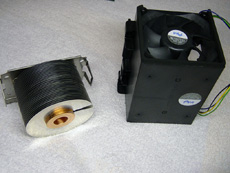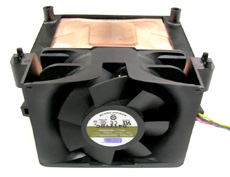Intel's Long Awaited BTX Form Factor
by Purav Sanghani on November 15, 2004 5:31 AM EST- Posted in
- Cases/Cooling/PSUs
BTX Cooling and Airflow
Again, the main reasoning behind Intel during the redesign of the ATX form factor was to design a more efficient cooling solution. As components are built faster they also run hotter. The ATX form factor improved on the AT specifications by placing the CPU closer to the back of the case where fans could be mounted as exhausts to pull hot air from the CPU out of the chassis and away from other components. Now that those other components in PCs are beginning to expand in performance and functionality they are running at temperatures as high as that of CPUs so a new design needed to be devised to help cool these components in a more efficient manner than just slapping more fans in a standard case. Now, we have come full circle with the CPU moving back towards the front of the case. Since Intel has the standards on PCIe very heavily controlled, worrying about PCIe cards extending too far to the front of the case should not be a problem.Intel implements a more efficient passive cooling system by placing the majority of components inline with the CPU towards the rear of the chasis.
 Click to Enlarge |
 Click to Enlarge |
The most important piece of hardware when it comes to cooling is the CPU heat sink fan. Without this a CPU would not POST, and would most likely damage the hardware. Intel has included what it calls a "BTX Thermal Module" which consist of either a spiral or stacked-fin heatsink and a fan which is mounted at the end of a plastic duct, facing the front end of the case. Intel has not limited this hardware to only one type though. In their virtual press kit Intel speaks of Type I (Standard height) and Type II (Low profile) thermal modules. The Type I module will be designed for a broader range of cases from small form factor to the larger full tower applications while the Type II module will be designed specifically for the ultra-small form factor designs.
 Click to Enlarge |
 Click to Enlarge |
Intel also mentioned that along with those two types of thermal modules there will be variations in the units for processors rated at different Thermal Design Power, or TDP levels. The difference in modules will exist mainly with the heatsink, with slight variations in the duct. The fan will, however, remain the same within the same type (Type I/Type II) of module.
This thermal module was the only piece of cooling hardware aside from the power supply which we found to be surprising. We couldn't imagine running an ATX case with only one CPU heatsink fan and we have our doubts about Intel's single module design, but we will leave that to our benchmarks to decide.










77 Comments
View All Comments
ZobarStyl - Monday, November 15, 2004 - link
God looking at those small cases makes me tremble and remember my parent's old IBM Pentium I system where you had to remove the PSU and the CD drive to install the RAM. I was so glad when I saw computers moving AWAY from this type of design...forget footprint, I want a case I can actually work in.Either way, congrats to Intel on making a new Delleron case, but I'm simply not interested. Great for OEM's but useless for me, just like most of Intel's products...
As for #3's question, why does Intel need it outside of helping their OEM buddies? Dual core is only going to make Prescott's heat issues stand out further and their x20/30/40's on the roadmap still are clocked in the range where they are going to be high heat output. All that heat has to go somewhere...
shabby - Monday, November 15, 2004 - link
#5 that must be the canadian version, it'll keep us warm during winter by exhausting warm air into our faces.Jeff7181 - Monday, November 15, 2004 - link
Am I reading this right... warm air from the CPU is exhausted out the FRONT of the case????mcveigh - Monday, November 15, 2004 - link
I can't get past page 1??????skunkbuster - Monday, November 15, 2004 - link
will intel even need btx anymore? since they are probably going to be dumping the p4 in favor of the pM(eventually)?i thought one of the main reasons why btx was designed was to better handle the hotter p4 processors and to cool them more efficiently?
PuravSanghani - Monday, November 15, 2004 - link
Thanks MAME, problem fixed :)MAME - Monday, November 15, 2004 - link
thumbnail of this article doesn't load on front page